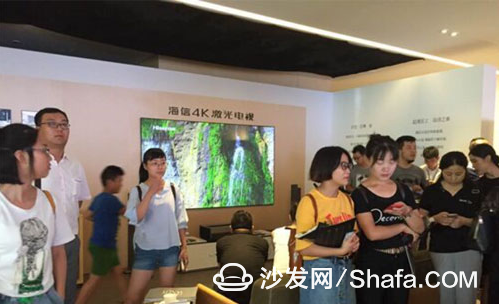The evolution of color TV technology has increasingly centered around innovation, with many manufacturers focusing not only on enhancing LCD displays but also exploring new frontiers like QLED, Micro LED, OLED, and laser technologies. Among these players, Hisense, a prominent name in China’s color TV sector, has decisively accelerated its investment in laser TV technology to secure a leadership position in the next wave of display advancements. This strategic move has yielded significant results.
According to my understanding, Hisense has been a key pioneer in the laser TV domain. Following the release of the world's first DLP ultra-short-throw 4K laser TV, Hisense recently unveiled a dual-color 4K laser TV, marking a substantial leap forward in terms of color gamut and brightness. To date, Hisense has secured over 320 core patents in the field of laser display and successfully transitioned from 2K to 4K resolution technologies.

Industry insiders note that laser display represents a promising trend in next-generation TV technology. Technically speaking, laser TVs offer a lighter and more efficient display approach compared to traditional LCD or OLED panels, particularly on larger screens. They consume fewer materials while delivering superior cost-effectiveness and holding significant potential for further innovation.
From an industrial perspective, the laser TV supply chain is highly diversified, offering ample opportunities for upstream and downstream companies to participate. Given that domestic TV manufacturers like Hisense have mastered the entire design and production process for laser TVs, it is anticipated that within the next 3-5 years, these TVs will complete their transition to full-color capabilities. Achieving full-color laser TVs will allow them to maximize their color and energy efficiency benefits, ultimately surpassing LCD TVs—a natural progression for laser TV technology.
Additionally, Hisense plans to debut its premium 4K laser TV in the U.S. market later this year, further expanding its presence in high-end international markets. Hisense has set a clear strategy to grow its brand globally, transitioning from OEM partnerships to independent branding. By Hisense’s estimates, this year’s overseas revenue is expected to account for more than half of its total earnings.

Currently, Chinese laser TV manufacturers are actively investing in R&D and producing top-tier products. With diligent execution in product development and marketing, these enterprises have amassed valuable experience, positioning them to potentially lead the global laser TV industry.
For those interested in smart TVs or boxes, platforms like the Sofa Butler (http://) provide comprehensive resources on TV boxes, smart TV software, and related information, serving as a go-to destination for enthusiasts and professionals alike.
KDA Miner
Kadena (KDA) is a hybrid blockchain network and smart contract platform that aims to unite public applications, private blockchains, and other interoperable chains in one place, driving traffic to the high-bandwidth computer at the heart of the Kadena public chain. Kadena`s mining algorithm is Blake2S, which supports ASIC mining.
Kadena is a blockchain network and smart contract token aiming to bring together both public applications and private blockchain.
The coin solves various problems that prevent blockchain adoption on a bigger scale. The protocol enables businesses and developers to make transactions and share information across many networks.
The Coin is actually on the grid to reduce users` experience in the network. Ethereum users experience a lot of network congestion which results in high gas fees.
A few changes have come into Kadena mining. A proof of work blockchain uses PACT to create smart contracts in the hidden gen. Therefore you need to know the following before mining Kadena. PACT is an intelligent contract language serving the needs of the blockchain community.
1.You Need an Excellent Mining Hardware
To mine efficiently, you will require suitable mining hardware. Kadena uses ASIC miners. But, unfortunately for Kadena miners, CPUs and GPUs are not usable. Furthermore, ASIC mining receives support from the Blake2S algorithm.
2.Make Sure You Have a Kadena Wallet Address
You will need a Kadena wallet address to receive and monitor your profit. F2pool also makes the distribution of the revenues to every user daily at 2KDA. The Kadena node wallet is a perfect wallet where you can receive your mined KDA. all you need to do is install it, click receive, and have a new wallet address.
You will need to configure your Asic Miner to a mining pool server for your hashrate and profit to be recorded and monitored.
3.Start Mining
After all the setting is done, your miner will be ready to work. Make sure you enter your wallet address and click on the go button to receive your revenue.
Kda Miner,Antminer Ka3 166Th,Bitmain Antminer Ka3 166Th,Antminer Bitmain Ka3
Shenzhen YLHM Technology Co., Ltd. , https://www.apgelectrical.com